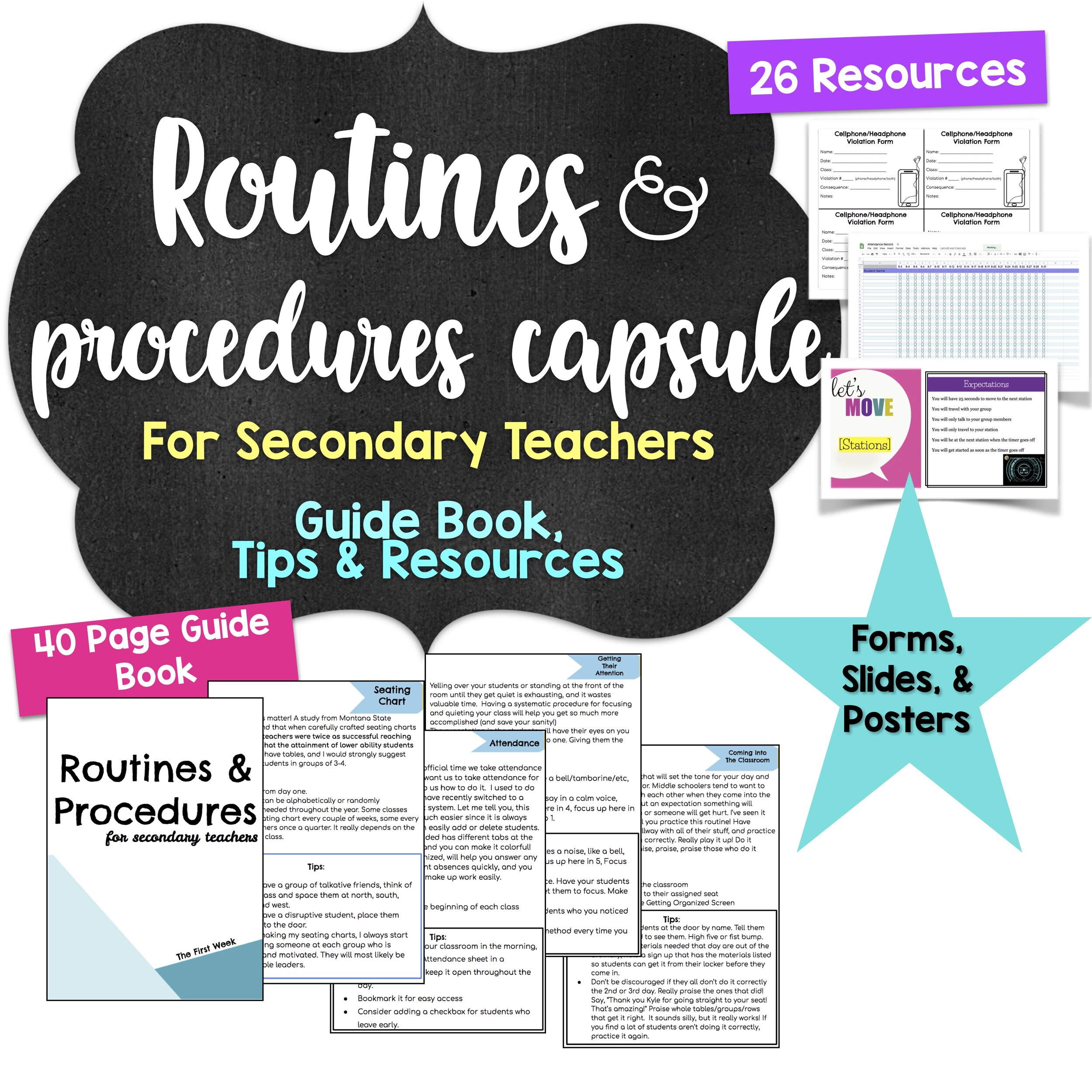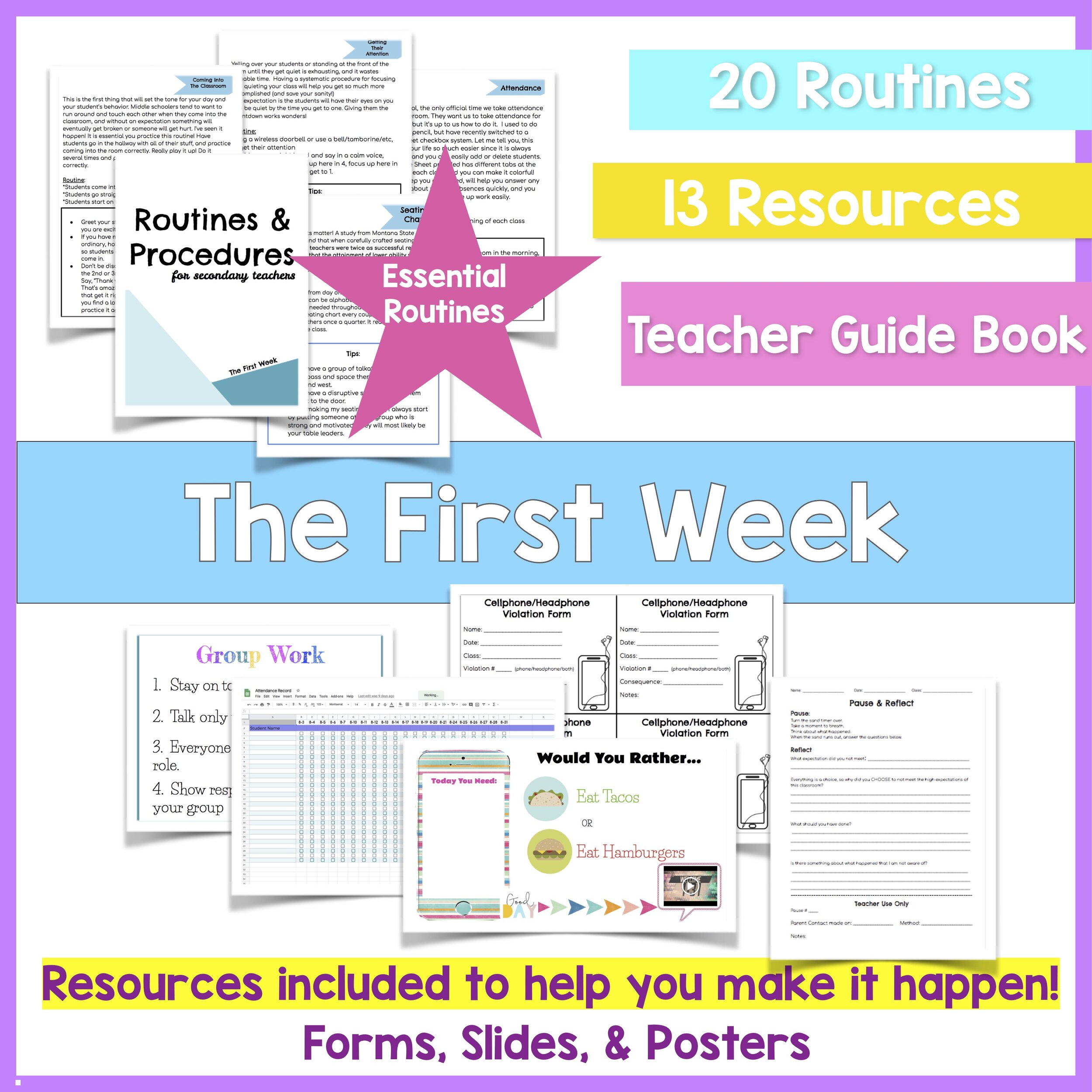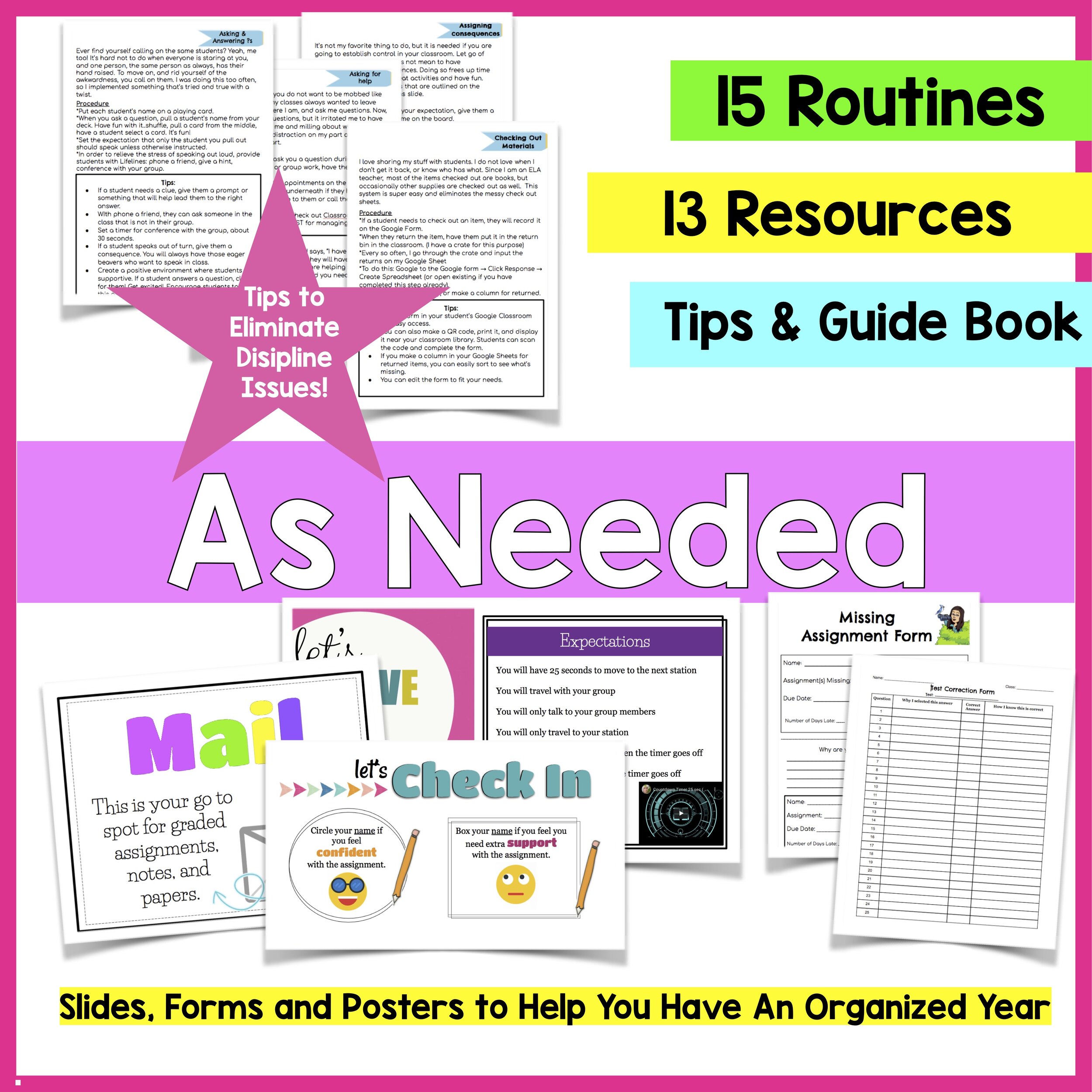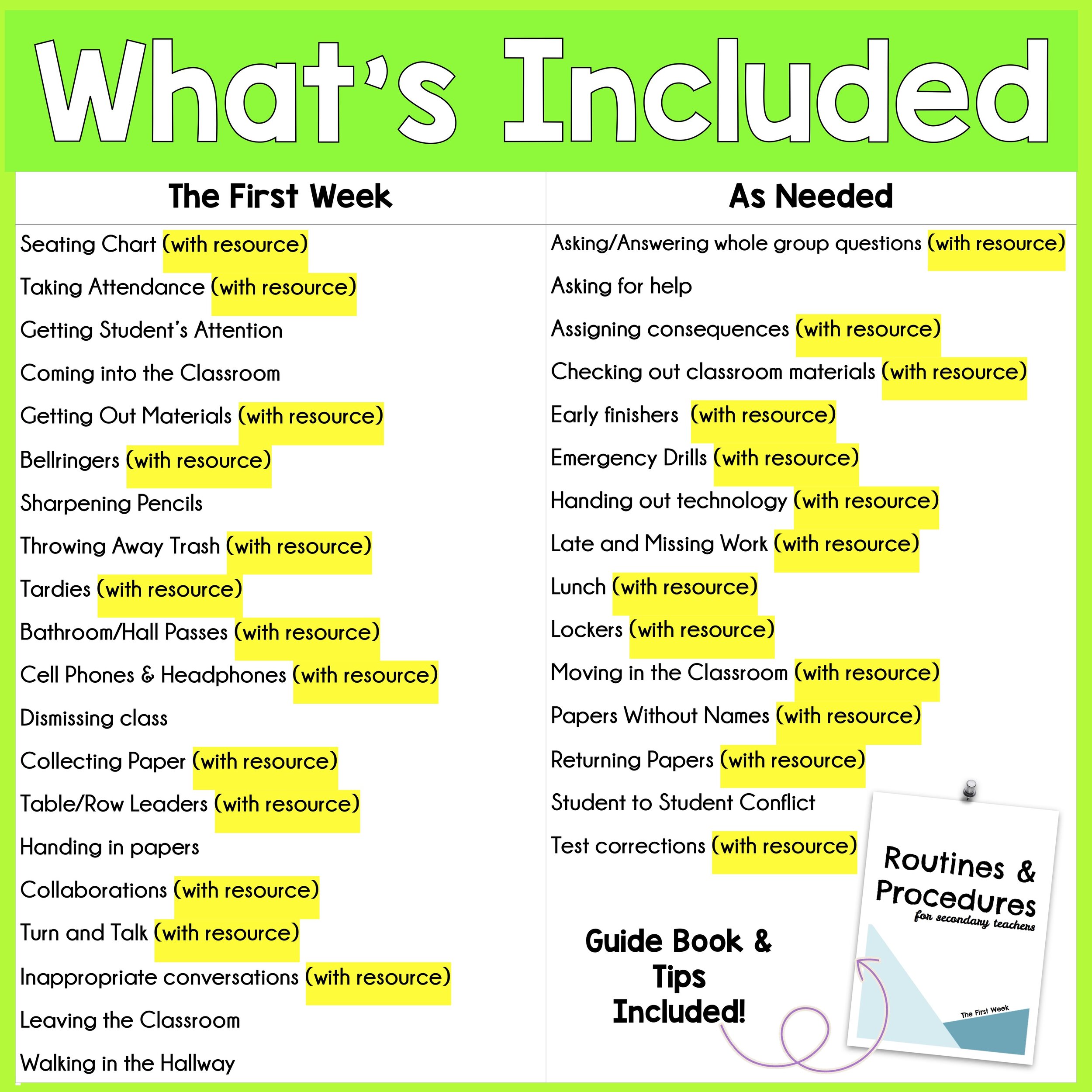5 Essential Routines and Procedures for Middle School Students
AHHHH! Middle school is a crazy time, right? Those fun mini-teenagers can be difficult to control sometimes, especially if they’re in a classroom that does not have a clear set of routines and procedures set in place.
I started my teaching career in the special education world. During this time I co-taught in various classrooms, and learned many lessons from veteran teachers. It was such an amazing experience since I was able to go into many classroom and saw first hand what methods worked and what led to chaos. The best piece of advice I walked away with from my years of co-teaching is that with structure comes freedom.
I vividly remember one classroom I co-taught in that did not have many (if any) routines set in place. The students would come in crazy, visit with their friends, and go in and out to use the restroom, and go to their locker whenever they wanted…all before class officially started!
The teacher would yell over their conversations to get them settled, and would start with whatever plans she had for the day once they all somewhat calm. Due to the craziness at the start, sometimes the lesson did not even start until 15-20 minutes into class.
Even once class finally got started there were problems. Students would get up while she was teaching, walk around, blurt out, and be unintentionally disruptive.
Don’t get me wrong, this teacher was great and I loved her as a person. She was knowledgeable and was really able to break concepts down into manageable pieces. However, due to the lack of structure, she missed out on being a true rockstar in her classroom. She did not have the freedom to teach like she wanted because she viewed her students as not being able to handle it. In reality, if she just had a few routines and procedures in place, she would have really been able to make more of an impact.
Through the years, I’ve learned structure helps you avoid burnout since you are not constantly battling your students, and it allows room for your creative juices to flow. I truly believe teachers like you want to make a difference, and effective and consistent routines and procedures will help you to fully embrace your passion for why you started teaching.
To help you get started, here are my top 5 essential routines I teach my middle school students the first week of school.
1. Coming Into The Classroom
Here is a video of my students coming to the classroom. Since we are always a work in progress, I have changed a couple of things since this video. The Getting Organized screen in more vibrant and the computers are now on their tables.
This procedure was born out of my old co-teaching days when I would be in classrooms that did not have a laid out plan for how students come into the classroom. Have you taught middle school? If so, then you know their natural instinct is to run around the classroom and try to touch each other. What is that about? Anyway, this routine is the first thing I teach my students since it’s critical to setting the mood for the day.
It’s simple: Students come in, go straight to their seat, and look at the Getting Organized screen.
I know what you’re thinking: Shouldn’t my students already do that?
Yes. They should. But for some reason, maybe it’s the lack of impulse control, they won’t do it unless it’s…
1. Explained, 2. Modeled, and 3. Practiced. <—- you can’t skip these steps.
Don’t fall into the trap of just telling them what you expect. That’s a great start, but you have to model what it looks like and doesn’t look like. Doing this will help your students know exactly what you expect. Then you need to practice, practice, and practice some more. Have students go in the hallway with all of their stuff, and practice coming into the room correctly. Really play it up! Do it several times and praise, praise, praise those who do it correctly.
When I do this with my students at the beginning of the year, there are a lot of high fives, pointing out who is doing it correctly, “Look at Makayla, y’all! She followed all the steps when she came into the room! WAY TO GO!” You can even keep Jolly Ranchers on hand for those who are meeting your expectations. (There is power in those little hard pieces of candy, y’all)
I praise, praise, praise students who do this routine correctly for the first two weeks. After that, it’s a habit and I rarely say anything about it….they just do it.
Yes, it takes a lot of time. Honestly, I spend almost a whole class period on this routine and the next one, but IT’S WORTH IT!
2. Getting Organized
My new Getting Organized screen. Everything they need is listed on the screen. They have three minutes to get organized and ready for the day.
In my experience, this is the second most important routine to teach to your students. I separate my class period into 4 sections: bellringer, vocabulary, standards practice, and reading. Before I started using the Getting Organized slide, by the end of the period, we would waste almost 10 minutes transitioning between sections. To reduce the time, I started having the students to get everything out and ready within the first three minutes.
I listed everything they needed throughout the class on the slide: homework, materials, book (open to the correct page), notebook set up like I have it on the board. The expectation is students come in, go to their seat, look at the slide, and get everything out in three minutes. Doing this one little routine has saved so much time.
Now, getting them to do this was not magical occurrence. I didn’t just tell them once and they did it every time. I combined teaching this routine with the first routine. We went into the hall, came into the room, and practiced getting everything out. I praised tables who all did it correctly, said thank you to students who were following the steps, and was genuinely excited when students were following the routine.
The next day some students don’t remember the routine, but some do. All I usually have to do is find some students that are doing the routine and say things like, “Thank you, River, for remembering the steps! You’re amazing!" Usually this will spur others into action. You can give the magical Jolly Ranchers to tables who have 100% that got everything out and ready in the three minutes.
If you notice the majority of students not doing the routine, don’t move on. Practice it again. It takes time in the beginning, but like the first routine, IT IS WORTH IT! After they get it down, your class will start smoothly and your administrators will be super impressed on how fast you start class and move between activities.
3. Seating Chart:
I know! It’s not groundbreaking, but it’s a total must have. A study from Montana State University found that when carefully crafted seating charts were in effect, teachers were twice as successful reaching students and that the attainment of lower ability students was doubled.
I have tables in my classroom, and I would strongly suggest putting your students in groups of 3-4 so they can work collaboratively. Don’t worry about them not being able to handle being close together in groups. You will have strong procedures and routines in place that will make sure they will thrive in small groups.
Pro Tip: If you have a group of talkative friends, think of a compass and space them at north, south, east, and west.
4. Getting Student’s Attention
The exact one I use is linked below. You can select a color that matches your class decor!
Yelling over your students or standing at the front of the room until they get quiet is exhausting and wastes valuable time. Having a systematic procedure for focusing and quieting your class will help you get so much more accomplished (and save your sanity!)
I jumped on the wireless doorbell craze, and got one for my classroom. I absolutely love it and use it 1,000 times a day. Don’t worry if you don’t have one, you can use anything that makes noise. Back in the day I had a tambourine and the guy down the hall had one of those little bells you see on hotel check in desks. It doesn’t matter what you have, you just need something to get their attention.
The most effective procedure I have found is to ring the bell, hold up your hand, and say in a calm, voice, “focus up here in 5, focus up here in 4, focus up here in 3…” Keep this up until you get to 1. I just added the ‘focus up here in 5…’ part this year and it was a total game changer. It allowed students to get to a good spot before turning their attention to me.
5. Pencils
Want to see my teacher head explode? Just get up during my teaching or when we’re reading to sharpen a pencil. AHHHHH! It drives me BANANAS! The pencil sharpener is the bane of my existence. Seriously, it is one of the few things I hate.
In middle school, sharpening a pencil is rarely about sharpening a pencil, it’s about trying to get attention or irritate someone. My solution- I removed it from the wall, said it broke, and banned wood pencils forever. For real, they are not allowed in my class. Most of my students love being able to write in colored pens and as a result, some of their notebooks become works of art.
If this is too extreme for you, there are a couple of things you can do: Have pre-sharpened pencils in each table’s supply box or handheld sharpeners. Students who need a sharpened pencil will use one out of the box and will return it at the end of class.
If you are providing pre-sharpened pencils in your supply box, mark them near the eraser with a sharpie (you can even color code them so you know which pencils go with which table)
Have a student helper in your last period or homeroom to sharpen the pencils everyday, replace as needed, and empty hand held pencil sharpeners.
The takeaway is you need a procedure to deal with sharpening pencils in order to keep your sanity.
Bonus: Trash
While I’m on the subject of things that irritate me, I will throw in a bonus routine.
The labels I put on the table trash cans. The containers are linked below.
Student’s throwing away trash is like dealing with pencil sharpening, you need to find a way to eliminate the need to take a stroll to the trash can. I did this by bring the trash cans to their tables! I use Glad food storage containers for this purpose, and they also serve double duty as table number markers! The ones I use in my classroom are linked below.
Model how you expect students to use the trash cans. Show them how to crumple up paper and place it in the can instead of throwing it basketball style, shoving it in, or laying it on top. Never assume. Always explain and model so students know what you expect.
Here are some quick tips about the trash cans on the tables:
If you allow gum, model how to wrap the gum in paper before placing it in the trash can.
If you teach middle school, you will have to model how the small trash cans are not hats. I speak from experience.
Have a student at the end of the day empty all of the trash cans. If it is a day where you are doing a lot of cutting/pasting, have your table leaders empty them at the end of class.
Use your trash cans as table markers. I place the label for each table on the container and put packing tape over it.
These 5 routines will help you take control of your middle school students!
I hope they jump start you in to creating or adding to your classroom routines.
If you want to dig deeper or want more of the routines, procedures, and resources I use to make sure my classroom runs as smoothly as possible with minimal discipline issues, check out my Routines and Procedures Capsule. It is a 40 page guide book and accompanying resources to help you start implementing immediately.




